Artificial Intelligence reinventing Healthcare Diagnosis: Endoscopic Procedure
Anmol Kalra | 17th September 2021
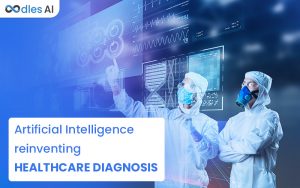
Artificial intelligence (AI), a discipline incorporated by data science, has seen recent rapid growth in its application to healthcare and beyond and is now emerging as an integral part of our daily life. Many industries have integrated their utility into offering better commodities and services to customers.
In healthcare, an interest in enhancing patient safety through improving diagnostic accuracy has driven research into understanding how AI-backed technology can work within the complexities of clinical medicine.
In this article, we Oodles AI will look upon how AI-backed tools and technologies are helping healthcare in clinical diagnosis procedures.
In connection with clinical diagnostics, we define AI as a tool that can correctly interpret health data, especially in its indigenous form as observed by humans. Usually, these clinical applications adopt various AI frameworks to enable the efficient interpretation of large complex datasets. These AI frameworks are trained on external health data that humans have usually interpreted and have been exponentially processed before exposure to the AI system.
Traditionally, clinical image labelling and its interpretation are made by a human expert. The AI system backed with these frameworks studies to execute the interpretation and clinical diagnostics task on new health data of the same type of condition, often identifying or forecasting a disease state.
Table of Content
♦ Diagnosing diseases in healthcare
♦ How machines diagnose life-threatening diseases
♦ Fusion of Artificial Intelligence in clinical diagnostics
♦ Artificial Intelligence in Endoscopic Procedure
♦ Preparing AI-Healthcare system module with Oodles AI
Diagnosing diseases in healthcare
Correctly diagnosing diseases can take years of medical training.
Even now, diagnostics is often a time-consuming, strenuous process. In many fields, the demand for experts outperforms the available supply. This puts doctors and medical staff under strain and often results in a delay in clinical diagnostics.
AI-backed Machine Learning and Deep Learning algorithms have recently made considerable progressions in clinical diagnostics of diseases, making automatic diagnostics cheaper and more convenient for the users.
A recent study published in the National Cancer Institute shows that the AI system has achieved a remarkable detection of breast cancer accuracy comparable to an average breast cancer radiologist.
How machines diagnose life-threatening diseases
Machine Learning algorithms with pre-trained frameworks can learn to see patterns similar to the way doctors see them. Machine Learning incorporated with doctors can help in the smooth diagnosis procedure.
AI-backed Machine Learning helps to perform various tasks, such as-
♦ Detecting symptoms of lung cancer or strokes based on CT scans
♦ Predicting heart strokes based on predictive analysis of the human body
♦ Assessing the risk of cardiac diseases based on electrocardiograms and cardiac MRI images
♦ Detecting cancer-causing elements using Endoscopic procedures
♦ Classifying skin lesions using Skin images and patterns
♦ Finding pointers of diabetic retinopathy based on Eye images
♦ Brain tumour segmentation using MRI imaging
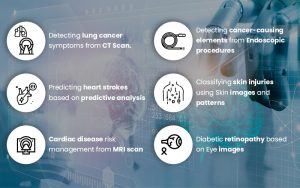
Fusion of Artificial Intelligence in clinical diagnostics
Artificial Intelligence uses various predictive analyses and DNN (Deep Neural Networks) to speed up the diagnosis process.
AI interpretation tasks in diagnosis can be arranged into-
➡ Computer vision
➡ Time-series analysis
➡ Speech recognition, and
➡ Natural language processing.
Each of these procedures is well suited to address specific types of clinical diagnostic tasks. For example, Computer vision is helpful in the interpretation of radiological images. Time series analysis is beneficial for the study of continuously gushing health data such as those provided by an electro-cardiogram.
Speech-recognition techniques are used to detect neurological disorders. AI-backed natural language processing(NLP) is helpful in the extraction of essential information from digital health record data made using Optical Character Recognition (OCR).
Artificial Intelligence in Endoscopic Procedure
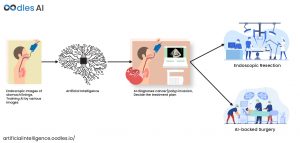
Process Involved in Endoscopic Procedure
➡ Preparation of AI system using captured images and data
➡ Detecting abnormal regions
♦ Colonic polyp detection
➡ Endoscopic procedure decision support system
♦ Anatomical structure understanding
♦ Segmentation and Labelling
➡ Medical staff support
♦ Surgical workflow analysis
CT/MR/ Endoscopy to post-operative follow-up chart

Steps involved in AI-based endoscopic procedures-
♦ Detailed CT/MR scans of the patient.
♦ The images then are segmented and analyzed based on their anatomical structures by using AI-backed neural networks.
♦ The physician then does surgical planning based on the findings of AI analysis.
♦ AI also helps make plans of surgeries to remove the abnormalities from the patient, which in turn reduces the risk factor involved.
♦ AI also aids in post-operative follow-ups with the patient.
Preparation of AI system using captured images and data
It is inconceivable that an AI system can be created that will work in every endoscopy process without any adjustment or protocols added. The development of an AI system requires a development phase where a network is being trained using images and data. It is a compute-intense process that happens on a large server or in the cloud. It results in a static model that can be used anywhere.
For data capture, there are three options: none, manual, and automated. The first option does not allow manual annotation and repeated training and testing of AI software. The second option, manual capture, requires an analog or digital video recorder and recording process. e.g., Video Capsule Endoscopy (VCE). The third option, automated capture, is used as an AI software where images obtained by manual capture are processed and used to train an automated AI-backed software module.
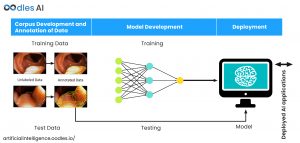
Detecting Abnormal Regions:- To detect abnormal regions, there is a need for measurement of the length or width of parts of the image that a physician observes during the procedure considering baseline and events, for
(i) Detecting anatomical GastroEsophageal Junction (GEJ) or Squamocolumnar epithelial junction (Z line)
(ii) Marking the highest border of red-coloured mucosa and polyp (abnormal tissue growths) considering its irregular or broken shape, traditionally called breaks and tongues.
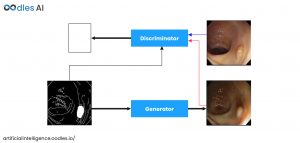
Endoscopic procedure decision support system
The anatomical structure understanding backed by the trained AI module serves as an Endoscopic procedure support system.
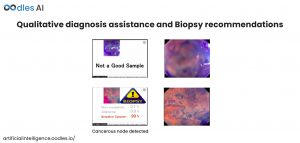
The preliminary decision of pointing a polyp as a cancerous node takes place here. In other words, we can understand that this is the decision-making step involving the recommendation of biopsy in the neural network process of AI-Endoscopy.
Anatomical structure AI – Segmentation
AI-backed Neural Networks allow us to segment anatomical regions under their structures from preoperative CTs, using convolutional networks like a unit. We run the cascading process in this unit to find the segmentation. Using this segmentation, we can find the anatomical structures from simple captured CT scan images.
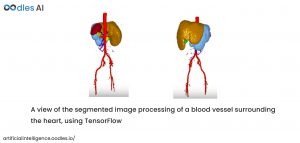
Anatomical structure AI – Labelling
The primary use of labelling images lies in the statement that “a computer is a machine.”
AI-based software finds it challenging to recognise the anatomical names from preoperative CT scans. To maintain the accuracy of the module, Anatomical structure AI-labelling is a must.
The process involves assigning anatomical names of each branch of the blood vessels using an AI convolutional neural network.

Assigning anatomical names to each blood vessel of the heart, using a Convolutional Graph Network
Medical staff support
This anatomical information has to be incorporated to assist surgical or Endoscopic procedures. A diagnostic pre-op Report is made using this labelled information about, e.g., blood vessel branching structure with its labelled name and information.
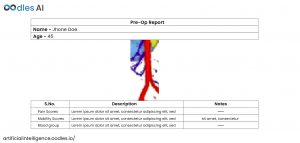
Preparing AI-Healthcare system module with Oodles AI
It is doubtful that AI will completely replace the human endoscopic process, which is not our ultimate goal.
Artificial Intelligence is meant to assist doctors and help to diagnose the optimal parts prone to develop a deadly disease in the future. The healthcare industry worldwide is experiencing colossal pressure to maintain the balance between innovative and accurate approaches. Even the ongoing pandemic situation has shown us how important the clinical diagnostic system is to contain the outbreak and spread of various diseases.
At Oodles AI, we are incorporating our innovative techniques and experience to build resilient solutions.
Join hands with our AI development team to help you in various domains around AI-diagnostics modules.



